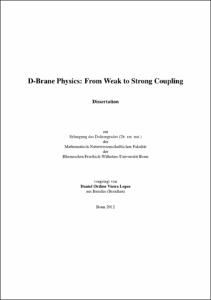D-Brane Physics: From Weak to Strong Coupling

D-Brane Physics: From Weak to Strong Coupling

| dc.contributor.advisor | Klemm, Albrecht | |
| dc.contributor.author | Ordine Vieira Lopes, Daniel | |
| dc.date.accessioned | 2020-04-18T16:49:01Z | |
| dc.date.available | 2020-04-18T16:49:01Z | |
| dc.date.issued | 04.03.2013 | |
| dc.identifier.uri | https://hdl.handle.net/20.500.11811/5618 | |
| dc.description.abstract | In this thesis we discuss two aspects of branes relevant to high-energy phenomenology. First, we consider a single D6-brane wrapping a special Lagrangian cycle and the background space compactified in a Calabi-Yau orientifold the conditions needed to obtain a four-dimensional N = 1 supersymmetric theory. We calculate the bosonic part of the effective action by performing a Kaluza-Klein reduction of the brane seven-dimensional action, and obtain the N = 1 characteristic data. To discuss the moduli, we first fix the moduli from deformations of the background Calabi-Yau and study the D-brane deformation moduli space. We next allow for Calabi-Yau deformations, and show that the moduli space for complex structure deformations is corrected by the fields living on the D6-brane. We also calculate the scalar potential from D- and F-terms generated from brane and background configurations that would break the supersymmetry condition. We then, via Mirror Symmetry, relate the spectrum obtained in our work to the spectrum in Type IIB effective theory with D3- D5- and D7-branes, and we propose a Kähler potential for the moduli space of brane deformations in Type IIB theories. In the second part of the thesis we discuss effects of brane intersections when the string coupling can become strong, and we work in the framework of F-theory. After reviewing the basics of F-theory constructions and a particular SU(5) model already discussed in the literature, we construct a model which contains a point of E8 singularity, and curves of E6 singularity. By explictly resolving the space, we show that the resolution requires the introduction of higher dimensional fibers, and argue how we can circunvent this problem for the E6 curve, leading to the expected resolution that generate an E6 group, while at the E8 point we cannot make the resolution lead to an expected E8 structure. | en |
| dc.language.iso | eng | |
| dc.rights | In Copyright | |
| dc.rights.uri | http://rightsstatements.org/vocab/InC/1.0/ | |
| dc.subject.ddc | 530 Physik | |
| dc.title | D-Brane Physics: From Weak to Strong Coupling | |
| dc.type | Dissertation oder Habilitation | |
| dc.publisher.name | Universitäts- und Landesbibliothek Bonn | |
| dc.publisher.location | Bonn | |
| dc.rights.accessRights | openAccess | |
| dc.identifier.urn | https://nbn-resolving.org/urn:nbn:de:hbz:5n-31119 | |
| ulbbn.pubtype | Erstveröffentlichung | |
| ulbbnediss.affiliation.name | Rheinische Friedrich-Wilhelms-Universität Bonn | |
| ulbbnediss.affiliation.location | Bonn | |
| ulbbnediss.thesis.level | Dissertation | |
| ulbbnediss.dissID | 3111 | |
| ulbbnediss.date.accepted | 10.01.2013 | |
| ulbbnediss.fakultaet | Mathematisch-Naturwissenschaftliche Fakultät | |
| dc.contributor.coReferee | Nilles, Hans-Peter |
Dateien zu dieser Ressource
Das Dokument erscheint in:
-
E-Dissertationen (4373)




